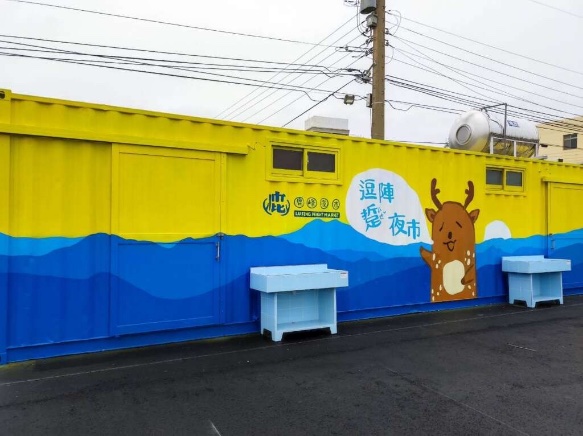New official night market sign with Taiwanese
« previous post | next post »
The Shalu district of Taichung (Taizhong) is opening a new night market:
Closeup:

(source)
The deer says:
逗陣踅夜市
That doesn't make sense in Mandarin (dòu zhèn xué yèshì) — except for the last two characters, which mean "night market".
It should be prono͘unced as tàu-tīn se̍h iā-chhī in Taiwanese.
tàu-tīn = together
se̍h = turn around, circumambulate
iā-chhī = night market
So "stroll around the night market" works, or simply "let's visit the night market", as it seems more like an invitation than an instruction.
Incidentally, 逗陣 is also written 鬥陣 and 湊陣.
Note that one character is glossed with zhuyin fuhao (phonetic symbols), but not with Mandarin (which would be ㄒㄩㄝˊ) . (source)
Sometimes 迺 is used instead of 踅 in Taiwanese. But both are obscure characters and not ones everyone is going to know.
Selected readings
- "French girl sells crêpes in a Taiwan market" (4/9/20)
- "Our Taiwan" (11/19/13)
- "The end of the line for Mandarin Phonetic Symbols?" (3/12/18)
- "How to learn to read Chinese" (5/25/08)
- "Mandarin morphosyllabic annotation of a Taiwanese sign" (5/13/19)
- "Ruby phonetic annotation for Cantonese" (5/6/19)
- "Phonetic annotations as a welcome aid for learning how to read and write Sinographs" (4/26/19) — with dozens of additional posts on the value of phonetic annotation listed in the "Readings" section at the end
- "Nontrivial script fail" (5/18/11)
- "A trilingual, triscriptal ad in the Taipei subway" (1/20/14)
- "A bilingual, biscriptal product designation in Taiwan" (2/7/14)
- "A museum for the languages of Taiwan" (1/5/20) — with a long bibliography on Taiwan language issues
- "'I am a Taiwanese" in Czech transcription'" (9/1/20)
[Thanks to Mark Swofford and Michael Cannings]

Victor Mair said,
April 22, 2022 @ 6:05 am
I asked Mark Swofford if Lufeng 鹿峰 (lit., "deer peak") is just the name of that night market or whether it had some special significance. In making a Google search for Lufeng 鹿峰, I noticeds that it seems to be fairly commonly / widely used for naming things.
Mark replied:
AntC said,
April 22, 2022 @ 7:07 am
Announcement in English.
@Mark That's the flatlands.
Yes, it's a pretty drab piece of coastline, and a long drive from the city. There's a decent seafood/hawker centre at 梧棲漁港 (Wuqi Fishing Harbour).
ohwilleke said,
April 22, 2022 @ 9:54 am
Was the blue and yellow intended to support Ukraine or was that just a coincidence?
AntC said,
April 22, 2022 @ 6:04 pm
Good question! I think just a coincidence. See these publicity photos with the yellow of the setting sun over the beach. (That windfarm is next door to Shalu; the beach with the people on is supposedly a nature reserve.)
The blue would be the mountains in the central massif (also featured in some of those photos), which rises east of Taichung City. (Taichung is the only major city not directly on the coast. As I said, Shalu is a long drive away.)
AntC said,
April 22, 2022 @ 6:16 pm
Taipei's Longshan Temple.
Then no surprise The area features neither dragons nor mountains.
AntC said,
April 22, 2022 @ 6:28 pm
While I'm at it, English wikipedia on Shalu.
Google Translate for that Chinese name doesn't give anything involving deer — although it's so nonsensical, I won't bother giving it here. Then I'm inclined to agree with Mark's probably been a toponym in the language of whatever tribe was there at the time.